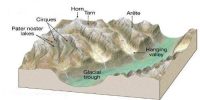Hail: It is a type of precipitation received in the form of ice pellets or hailstones. The size of hailstones can be between 5 and 190 mm in diameter. It is a precipitation in the structure of small balls or lumps generally consisting of concentric layers of clear ice and solid snow. Any thunderstorm which constructs hail that reaches the ground is known as a hailstorm. Hail has a width of 5 millimeters (0.20 in) or more.

Hail forms in strong thunderstorm clouds, mainly those with deep updrafts, lofty liquid water contented, huge vertical extent, large water droplets, and where a good portion of the cloud layer is below freezing 0 °C (32 °F). These types of strong updrafts can also signify the occurrence of a tornado. The growth rate is maximized where the air is close to a temperature of −13 °C (9 °F). When the hailstone is lifted, it hits liquid water droplets. Those droplets then freeze to the hailstone, adding another layer to it. The hailstone ultimately falls to Earth when it becomes too weighty to stay in the cloud, or when the updraft stops or slows down.
















